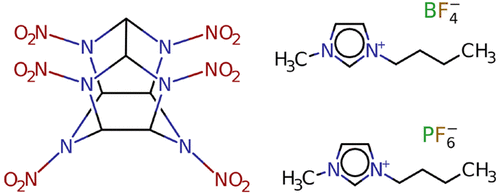当前位置:
X-MOL 学术
›
Cryst. Growth Des.
›
论文详情
Our official English website, www.x-mol.net, welcomes your
feedback! (Note: you will need to create a separate account there.)
Crystal Solvates of Energetic 2,4,6,8,10,12-Hexanitro-2,4,6,8,10,12-hexaazaisowurtzitane Molecule with [bmim]-Based Ionic Liquids
Crystal Growth & Design ( IF 3.2 ) Pub Date : 2019-06-04 00:00:00 , DOI: 10.1021/acs.cgd.8b01835 Ivan V. Fedyanin 1 , Konstantin A. Lyssenko 1, 2 , Leonid L. Fershtat 3 , Nikita V. Muravyev 4 , Nina N. Makhova 3
Crystal Growth & Design ( IF 3.2 ) Pub Date : 2019-06-04 00:00:00 , DOI: 10.1021/acs.cgd.8b01835 Ivan V. Fedyanin 1 , Konstantin A. Lyssenko 1, 2 , Leonid L. Fershtat 3 , Nikita V. Muravyev 4 , Nina N. Makhova 3
Affiliation

|
Crystallization of different biological targets and pharmaceuticals from ionic liquids (ILs) could result in previously unknown polymorph modifications. Crystallization of high-energy materials (HEMs) from ILs has not been studied so far. This paper is devoted to the first attempts to crystallize a highly energetic compound—2,4,6,8,10,12-hexanitro-2,4,6,8,10,12-hexaazaisowurtzitane (HNIW or CL-20) from different ILs. However, instead of the possible polymorphs these investigations unexpectedly resulted in multicomponent crystal solvates containing an HNIW molecule and anions and cations of two ILs—1-butyl-3-methylimidazolium hexafluorophosphate ([bmim][PF6]) and 1-butyl-3-methylimidazolium tetrafluoroborate ([bmim][BF4]). Their structure was determined by single-crystal X-ray diffraction analysis. The HNIW molecule in both structures adopts different but the most common conformations, similar to the β- and γ-polymorphs of the pure HNIW. Crystal packing was analyzed in terms of extended Hirshfeld surface analysis that allowed distinguishing the contacts between different solvate components. In HNIW·[bmim][PF6] intermolecular bonding interactions were also analyzed by topological analysis of theoretical (B3LYP-D3/POB-TZVP) electron density distribution. It was found that, despite small difference in the ionic liquid, the arrangement of crystal components in two solvates differs significantly. In HNIW·[bmim][PF6] with a chainlike packing pattern of the HNIW molecules the HNIW···HNIW interactions play a much lesser role than in HNIW·[bmim][BF4] with layerlike arrangement of the energetic molecules. The presence of the anion and cation of the ionic liquid significantly decreases the melting point and density of the materials, relative to ε-HNIW. Importantly, the sensitivity to impact (18 J) measured for HNIW·[bmim][BF4] is also significantly lower as compared to ε-HNIW (4 J).
中文翻译:

含[bmim]离子液体的高能2,4,6,8,10,12-六硝基-2,4,6,8,10,12-六氮杂异纤锌矿型结构分子
从离子液体(IL)结晶不同生物靶标和药物可能会导致以前未知的多晶型物修饰。迄今为止,尚未研究过从离子液体中结晶高能材料(HEM)的问题。本文致力于首次尝试从中结晶出高能化合物-2,4,6,8,10,12-六硝基-2,4,6,8,10,12-六氮杂异纤锌矿型结构烷烃(HNIW或CL-20)不同的IL。然而,代替可能的多晶型,这些研究出乎意料地导致了包含HNIW分子以及两个ILs的阴离子和阳离子的六氟磷酸1-丁基-3-甲基咪唑鎓([bmim] [PF 6 ])和1-丁基-3的多组分晶体溶剂化物。-甲基咪唑四氟硼酸盐([bmim] [BF 4])。通过单晶X射线衍射分析确定它们的结构。两种结构中的HNIW分子采用不同但最常见的构象,类似于纯HNIW的β和γ多晶型物。根据扩展的Hirshfeld表面分析对晶体堆积进行了分析,该表面分析可以区分不同溶剂化物组分之间的接触。在HNIW·[bmim] [PF 6 ]中,还通过理论(B3LYP-D3 / POB-TZVP)电子密度分布的拓扑分析来分析分子间键合相互作用。已发现,尽管离子液体的差异很小,但两种溶剂化物中晶体组分的排列却有很大不同。在HNIW·[bmim] [PF 6中]具有HNIW分子的链状堆积模式,HNIW···HNIW相互作用的作用要比具有高能分子的层状排列的HNIW·[bmim] [BF 4 ]小得多。相对于ε-HNIW,离子液体中阴离子和阳离子的存在显着降低了材料的熔点和密度。重要的是,与ε-HNIW(4 J)相比,对HNIW·[bmim] [BF 4 ]测得的撞击敏感性(18 J)也大大降低。
更新日期:2019-06-04
中文翻译:

含[bmim]离子液体的高能2,4,6,8,10,12-六硝基-2,4,6,8,10,12-六氮杂异纤锌矿型结构分子
从离子液体(IL)结晶不同生物靶标和药物可能会导致以前未知的多晶型物修饰。迄今为止,尚未研究过从离子液体中结晶高能材料(HEM)的问题。本文致力于首次尝试从中结晶出高能化合物-2,4,6,8,10,12-六硝基-2,4,6,8,10,12-六氮杂异纤锌矿型结构烷烃(HNIW或CL-20)不同的IL。然而,代替可能的多晶型,这些研究出乎意料地导致了包含HNIW分子以及两个ILs的阴离子和阳离子的六氟磷酸1-丁基-3-甲基咪唑鎓([bmim] [PF 6 ])和1-丁基-3的多组分晶体溶剂化物。-甲基咪唑四氟硼酸盐([bmim] [BF 4])。通过单晶X射线衍射分析确定它们的结构。两种结构中的HNIW分子采用不同但最常见的构象,类似于纯HNIW的β和γ多晶型物。根据扩展的Hirshfeld表面分析对晶体堆积进行了分析,该表面分析可以区分不同溶剂化物组分之间的接触。在HNIW·[bmim] [PF 6 ]中,还通过理论(B3LYP-D3 / POB-TZVP)电子密度分布的拓扑分析来分析分子间键合相互作用。已发现,尽管离子液体的差异很小,但两种溶剂化物中晶体组分的排列却有很大不同。在HNIW·[bmim] [PF 6中]具有HNIW分子的链状堆积模式,HNIW···HNIW相互作用的作用要比具有高能分子的层状排列的HNIW·[bmim] [BF 4 ]小得多。相对于ε-HNIW,离子液体中阴离子和阳离子的存在显着降低了材料的熔点和密度。重要的是,与ε-HNIW(4 J)相比,对HNIW·[bmim] [BF 4 ]测得的撞击敏感性(18 J)也大大降低。












































 京公网安备 11010802027423号
京公网安备 11010802027423号